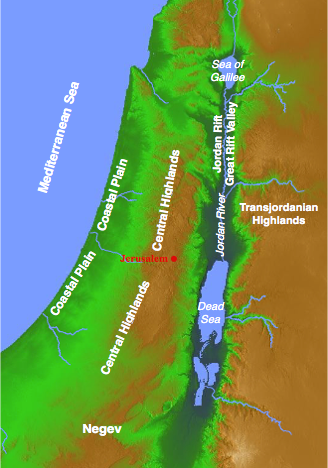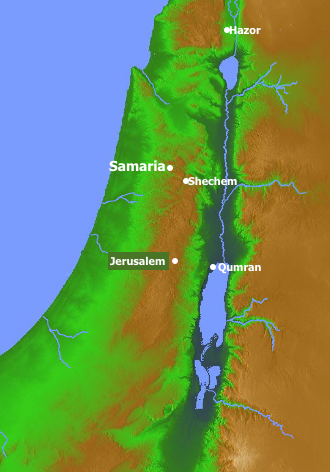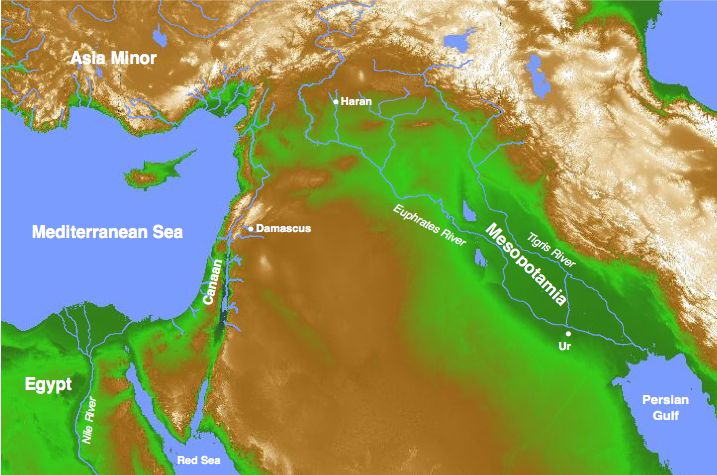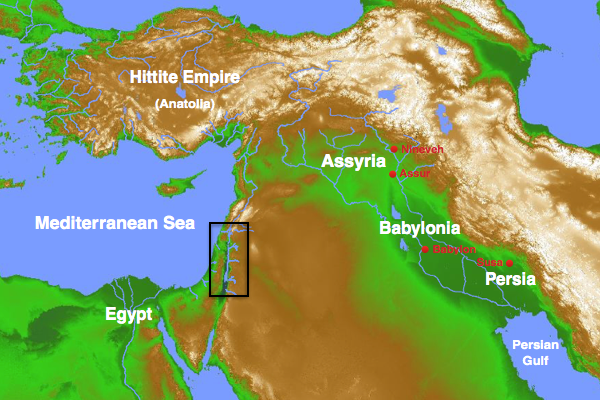Introduction
Understanding the geographical references in a particular biblical text can sometimes make a significant difference in understanding the point the author is making. Similarly, having an understanding of the historical circumstances under which a text was written as well as the history about which it speaks can make a dramatic difference in how you understand the author’s comments.
This chapter provides a very basic overview of some of the information you will need in order to understand the remainder of this book. Later chapters expand on the information presented here and in some cases revise it as we see reasons to make dates and locations more precise.
Geography
It is useful to understand the topography of the land mass at the eastern end of the Mediterranean Sea as well as the locations of cities that figure prominently in the biblical narratives. Let’s look first at the lay of the land.
Topography of the Ancient Near East
 Here is a list of significant geographical features of the Ancient Near East in the immediate area of Israel. You will understand other parts of this book more easily if you take the time to locate them now.
Here is a list of significant geographical features of the Ancient Near East in the immediate area of Israel. You will understand other parts of this book more easily if you take the time to locate them now.
- The Coastal Plain
- The Central Highlands/Central Hill Country
- The Jordan Rift/Great Rift Valley
- The Transjordanian Highlands/Transjordan
- The Jordan River
- The Sea of Galilee
- the Dead Sea
- The Mediterranean Sea
You may also want to note the Negev (“dry land”) to the south of the Central Highlands.
Moving eastward from the Mediterranean Sea, you would come ashore on the Coastal Plain. Moving farther East the ground begins to rise into a mountainous region called the Central Highlands or the Central Hill Country. Still further East the land drops sharply into the Jordan Rift, a deep valley at the bottom of which runs the Jordan River. The Sea of Galilee is near the northern end of this valley, and the Dead Sea is at the southern end. Continuing eastward, the land rises on the eastern side of the Jordan into a region called the Transjordanian Highlands. This region is sometimes called simply Transjordan, meaning “across the Jordan (River).” The regions of Edom, Moab, Ammon, Gilead, and Bashan (not labelled on the map here) are all located in the Transjordanian Highlands.
Cities to Locate
 You should be able to identify the following cities on a map of Israel:
You should be able to identify the following cities on a map of Israel:
- Hazor lies to the north of the Sea of Galilee, but south of Lake Huleh.
- Shechem was located to the southeast of the later city of Samaria.
- Samaria The city of Samaria, not the region known by that name, lay near Shechem, but slightly to the northwest. Both cities were located in the region later called Samaria.
- Jerusalem is located in the central highlands west of the northern end of the Sea of Galilee. For most of the period covered by the biblical documents, Jerusalem was the most important religious center for the Israelite people.
- Qumran was located on the north-west shore of the Dead Sea, almost directly east from Jerusalem and south from Jericho. The Dead Sea Scrolls were discovered near Qumran.
You will also need to identify these cities on a map of the larger region (See the maps below):
- Ur was an ancient city in southern Mesopotamia.
- Haran was located at the northernmost end on the fertile crescent.
You should also have a rough idea of the routes of two important highways: the Via Maris (way of the sea) and the King’s Highway (North/South through the Transjordan). These highways are not pictured on the maps presented here. The Via Maris ran from Egypt in the South to Damascus in the far North. For most of this distance it followed the shore of the Mediterranean Sea. As one traveled north the highway moved inland passing through Hazor, then turned East to cross the Jordan River and continue northeast to Damascus. The Kings Highway ran north and south through the Transjordan.
History
The biblical documents discuss events from an extremely wide range of historical periods. Throughout this course you will learn information about various parts of that history. Here I present only some basic information about the origins of the ancient nation of Israel and the major international powers that influenced its development.
The origins of Israel:
The Hebrews/Israelites/Jews and
The land of Canaan/Israel/Palestine
The name “Israel” comes from one of the ancestors of the people known by that name. According to Genesis Jacob, the grandson of Abraham, had his name changed to ‘Israel’ by God. His descendants eventually became known as the people of Israel (i.e. the descendants of Israel).
The book of Genesis presents Abraham, the grandfather of Jacob (later called Israel), leaving his homeland in Ur, a city in southern Mesopotamia, and traveling to Haran in the northernmost extension of the fertile crescent. He later leaves Haran and travels south to the land of Canaan.

Abraham and his descendants are presented as nomadic people. The people of Canaan called such nomadic groups ‘Apiru (Habiru). In the language of Abraham’s descendants, this word became ‘ibri, which we translate into English as ‘Hebrew‘. Not all of the people called ‘Apiru by the Canaanites, though, were what the Bible calls Hebrews.
The account in the Torah continues by saying that the descendants of Jacob (Israel) were eventually enslaved by the Egyptians. After several hundred years in captivity, they were delivered under the leadership of Moses. They returned to a nomadic lifestyle for about one generation, then came to occupy the land of Canaan, renaming it “Israel“. They came to be known as “Israelites“. The change of name of the land from Canaan to Israel coincides with the change in the name of the people from Hebrews to Israelites.
The term Israel is ambiguous. It is sometimes used to refer to the people (the nation), sometimes to the place where those people lived (the land of Israel) and later to the northern part of that land, where 10 of the original 12 tribes lived after the nation split in 922 BCE. After that split, the area occupied by the two southern tribes was called ‘Judah‘ (after the tribe of Judah), and the people who lived there are often called Judeans.
In 721/722 BCE the northern kingdom (still called ‘Israel’) was defeated by the Assyrians. The leading citizens were carried off into captivity, and the northern kingdom (Israel) was never reestablished. After this time the term Israel is sometimes used to refer to the occupants of the southern kingdom (Judah), further confusing the terminology.
In 587 BCE the Babylonians conquered the southern kingdom, Judea, and took its leading citizens off into captivity. A little over one generation later, when the Persians conquered the Babylonians, the people of Judea were allowed to return home. Over time they came to be called ‘Jews‘, a shortened form of ‘Judeans’.
When the Romans conquered the region shortly before the time of Jesus, they took the name, ‘Philistia‘ (which had earlier applied only to the southwestern coastal plain occupied by the Philistines), and applied it to the entire region , including the land occupied by the Jews and their neighbors. It is from this word, ‘Philistia,’ that we get our modern English name ‘Palestine.’
Major Powers in the Ancient Near East and their Influence on Israel
You should be able to identify the following centers of power on a map.
Egypt
Egypt was a power long before the rise of Israel and remained a significant force until the time of the rise of Christianity (although it was under Greek rule for the later part of this period).
According to Genesis, Abraham’s grandson, Jacob and his family pushed by famine in Canaan, went to Egypt to find food. Their descendants were eventually enslaved by the larger Egyptian society according to the book of Exodus.
Some have proposed that the earliest Hebrews arrived in Egypt during the reign of the Hyksos, a semitic group that had infiltrated Egyptian society in the 17th century BCE and ruled until 1560 BCE, but the evidence is inconclusive. If the Hebrew people were in Egypt at the time of the Hyksos, they would have been there at the time of Amenhotep IV—who changed his name to Akhenaton (Akhen-Aton, “It is well with Aton”). Akhenaton demanded that only Aton, the sun god be worshipped. He appears not to have claimed that Aton was the only god in existence, but that only he should be worshiped in Egypt. Evidence of monotheism, the view that there is only one God, comes much later.
The narrative at the beginning of Exodus presents the hebrew people as escaping slavery in Egypt. Some have argued that this could have taken place under Ramses II (1290-1224 BCE), during the height of the Egyptian Empire, but again, the evidence for this is not conclusive. Ramses II tended to record even his defeats as victories, so if the Hebrews were in Egypt and escaped at this time, it would make sense that the event is not mentioned in the Egyptian records.
Whatever we think about the historicity of these early narratives, it is likely that the Israelites (as the Hebrews were called after they established themselves in Canaan) had already settled in Canaan by 1220 BCE. Egyptian records tell of Merneptah (the son of Ramses II) defeating the Israelites in Canaan around that time.
The Hittite Empire
The Hittites, located in Anatolia (later called Asia Minor) northwest of the Fertile Crescent, fought with the Egyptians at about this time, creating a balance of power that would allow an opportunity for changes of control in Canaan (located within the rectangle in the map above). This is likely to be the period at which the Hebrew people took control there.

Three Mesopotamian Empires:
Assyria, Babylonia, Persia
Three different empires based in Mesopotamia, the land between the Tigris and Euphrates Rivers would later dominate Israel.
The Assyrians, located in central Mesopotamia, eventually conquered the Northern Kingdom of Israel (721-722 BCE) and took its upper class people away into captivity. They resettled some of their own people among the remaining Israelites. While the Assyrians never completely destroyed the Southern Kingdom (Judah), they did defeat most of its cities and put constant pressure on Judah in the forms of taxes and threats.
The Babylonians, located in southern Mesopotamia, conquered the Southern Kingdom (Judah) and took some of its leading citizens into exile in 597 BCE, making Judah a vassal state. In 589-587 BCE Judah rebelled. The Babylonians destroyed Jerusalem and took the remaining upper class citizens into captivity.
The Persians, later conquered the Babylonians and allowed the Jews to return home (+/- 538-539 BCE). Judah remained a vassal state in the Persian Empire until Alexander the Great defeated the Persians in 333 BCE.
The Greeks (Macedonians)
In 333 BCE Alexander the Great wrested Judah from Persian control and took it into his growing Empire. The Greeks dominated the territory of the old state of Israel from 333 BCE till the late 160’s when Israel won its independence. Greek thought and customs still continued to have an influence in the region long after this time.
The Romans
The Romans took control of Israel in 63 BCE in the middle of a dispute between two rival Jewish leaders. They ruled the area through client kings and direct governors until well after the lifetime of Jesus.
Major Periods in the History of Ancient Israel
You should learn the dates for the following periods and be able to give a brief explanation of the name of each. Why is the first period called the “patriarchal” period, for example?
Name of
|
Approximate Dates |
Description |
| Patriarchal Period or Ancestral Period | perhaps as early as c. 1850-1700 BCE but possibly later |
|
| Mosaic Period | perhaps c. 1250-1200 BCE | This period begins with the rise of Moses in Egypt, includes the departure of the Hebrew people from Egypt, and ends with the death of Moses on the border of Canaan. |
| Period of the Judges | perhaps c. 1200-1020 BCE | The period of the judges begins with the conquest/infiltration of the land of Canaan and ends with the naming of Saul as Israel’s first king. |
| The United Kingdom | c. 1020-922 BCE | The United Kingdom lasted for a very short time. All Israel was united under Saul, then David, then Solomon. At the death of Solomon the nation divided over the choice of Solomon’s successor. |
| The Divided Kingdom | c. 922-721 BCE | On the death of Solomon the nation of Israel split. The northern ten tribes kept the name “Israel” and the southern tribes adopted the name “Judah”. These two new nations coexisted until 721 BCE when the Assyrians destroyed the northern kingdom. |
| The Judean Period | c. 721-587 | After the destruction of the northern kingdom, Judah existed without its northern neighbor until it was conquered by the Babylonians in 597 BCE and destroyed in 587. |
| The Babylonian Exile | c. 587-538 BCE | Both in 597 and 587 BCE the Babylonians took Judean captives into exile in Babylon. They remained there until freed by Cyrus of Persia in 538 BCE. Some stayed in Babylon even after Cyrus freed them. |
| The Persian Period | c. 538-333 BCE | From 538 to 333 BCE Judah remained under Persian control. The former nation was now a province of the Persian Empire. |
| The Hellenistic Period | c. 333-63 BCE | In 333 BCE Alexander the Great wrested Judah from Persian control and began an aggressive policy of hellenization (imposition of hellenisticculture). [The people that English speakers call Greeks called themselves the Hellens.] From this time forward until the mid 160’s BCE Judah was ruled directly by foreign (usually Syrian) Greek rulers. In the 160’s Israel (originally only Judah but later the old northern kingdom as well) won its independence. The Greek influence remained strong, though, even in this period of independence. |
| The Roman Period | 63 BCE-135 CE | In 63 BCE the Romans responded to a plea for assistance in a dynastic struggle in Israel and took control of the region. They continued the policies of hellenization begun by Alexander. |
Concluding Summary
The history of ancient Israel was varied and often violent, with frequent brief periods of peace punctuated by wars beyond the control of the small nation surrounded by world powers. As we read the documents that stem from various points in the history of this small region, it will be necessary to expand on the limited introduction you have read here.
Understanding the geographical references in a particular biblical text can sometimes illuminate our understanding of the point the author is making. Having a clear understanding of the historical circumstances under which a text was written as well as the history about which it speaks can also make a significant difference in how we understand the author’s comments.